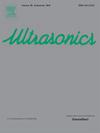Temperature-activated coupling effect of nano-Ag coupled ultrasonic transducer during heating process
IF 3.8
2区 物理与天体物理
Q1 ACOUSTICS
引用次数: 0
Abstract
High-temperature ultrasonic transducers (HTUTs) are critical for structural health monitoring (SHM). While many existing studies on HTUTs prioritize maximizing operational temperatures or focus on singular high-performance piezoelectric materials or robust bonding techniques like brazing for extreme conditions, this work distinguishes itself by comprehensively investigating a synergistic, multi-component system specifically optimized for stable, well-characterized performance and revealing novel interfacial phenomena within the industrially prevalent 350 °C range. We introduce a HTUT innovatively constructed using a nano-Ag coupling layer, graphite conductive glue for reliable electrical contacts, and mica high-temperature wire. The transducer’s performance and underlying mechanisms are systematically assessed from 20 °C to 350 °C. Results demonstrate exceptional high-temperature adaptability with stable echo characteristics. A primary distinguishing contribution is the identification and characterization of a “Temperature-Activated Coupling Effect”. Unlike the monotonic performance degradation often anticipated or observed with increasing temperature in many systems, the Temperature-Activated Coupling Effect reveals a unique window where peak-to-peak voltage and SNR are enhanced after surpassing a specific thermal threshold. This phenomenon, attributed to thermally induced improvements at the nano-Ag coupling interface, offers novel insights for optimizing transducer performance. While the mechanical coupling coefficient showed a complex trend, peaking at 100 °C, the overall significance of this study lies in its holistic design approach and the elucidation of the Temperature-Activated Coupling Effect, offering a practical and mechanistically insightful advancement beyond simply achieving temperature tolerance. This provides a distinct pathway for developing HTUTs with tailored performance enhancements for moderately high-temperature SHM applications, contrasting with approaches solely focused on ultimate temperature limits or single-material improvements.
纳米银耦合超声换能器在加热过程中的温度激活耦合效应
高温超声换能器(HTUTs)是结构健康监测的关键。虽然许多现有的htut研究优先考虑最大限度地提高工作温度,或专注于单一高性能压电材料或坚固的粘合技术,如极端条件下的钎焊,但这项工作的特点是全面研究了一种协同的多组分系统,专门针对稳定、特性良好的性能进行了优化,并揭示了工业上普遍存在的350°C范围内的新界面现象。我们介绍了一种采用纳米银耦合层、可靠电触点的石墨导电胶和云母高温导线创新构建的HTUT。从20°C到350°C,系统地评估了换能器的性能和基本机制。结果表明,该系统具有良好的高温适应性和稳定的回波特性。一个主要的显著贡献是“温度激活耦合效应”的识别和表征。在许多系统中,随着温度的升高,通常会预期或观察到单调的性能下降,而温度激活耦合效应揭示了一个独特的窗口,在超过特定的热阈值后,峰值电压和信噪比会增强。这种现象归因于纳米银耦合界面的热诱导改进,为优化换能器性能提供了新的见解。虽然机械耦合系数呈现复杂趋势,在100℃时达到峰值,但本研究的总体意义在于其整体设计方法和对温度激活耦合效应的阐明,提供了超越简单实现耐温性的实用和机械上的深刻见解。这为开发适合中高温SHM应用的htut提供了独特的途径,而不是仅仅关注极限温度限制或单一材料的改进。
本文章由计算机程序翻译,如有差异,请以英文原文为准。
求助全文
约1分钟内获得全文
求助全文
来源期刊

Ultrasonics
医学-核医学
CiteScore
7.60
自引率
19.00%
发文量
186
审稿时长
3.9 months
期刊介绍:
Ultrasonics is the only internationally established journal which covers the entire field of ultrasound research and technology and all its many applications. Ultrasonics contains a variety of sections to keep readers fully informed and up-to-date on the whole spectrum of research and development throughout the world. Ultrasonics publishes papers of exceptional quality and of relevance to both academia and industry. Manuscripts in which ultrasonics is a central issue and not simply an incidental tool or minor issue, are welcomed.
As well as top quality original research papers and review articles by world renowned experts, Ultrasonics also regularly features short communications, a calendar of forthcoming events and special issues dedicated to topical subjects.
 求助内容:
求助内容: 应助结果提醒方式:
应助结果提醒方式:


